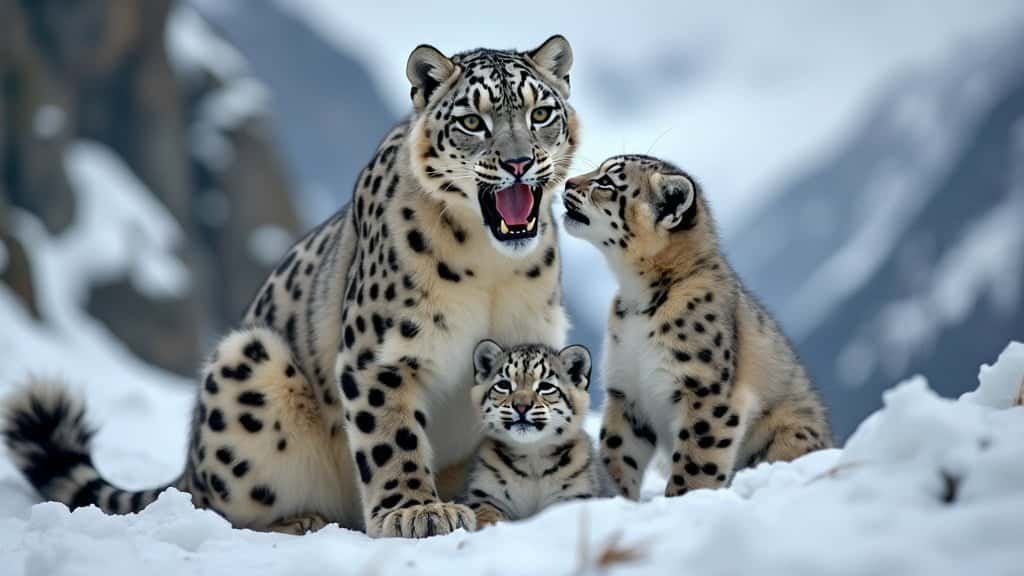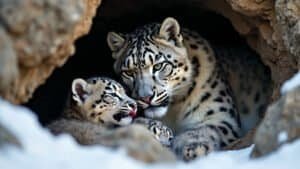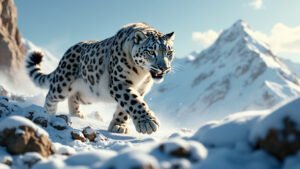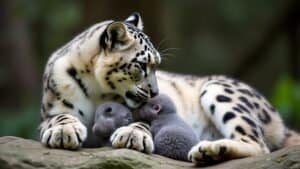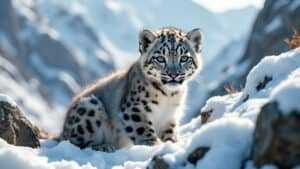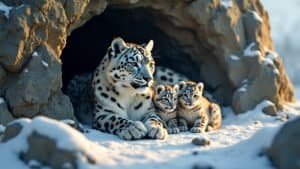Introduction
Snow leopard cubs grow up in harsh environments, making the development of communication and social skills essential for survival. From an early age, these cubs begin to learn how to communicate and interact with their mother, siblings, and eventually other snow leopards
This article explores how they develop vocalizations, the role of play in social bonding, how they recognize family members, and the importance of mimicking adult behaviors
Understanding these processes provides insight into how snow leopards maintain social structures and thrive in the wild
Learning Vocalizations From Their Mother
Snow leopard cubs rely heavily on their mother during the early stages of life, especially when it comes to learning how to communicate. Vocalizations are a critical component of their interaction and survival in the wild
From birth, cubs are exposed to various sounds and calls made by their mother, which serve not only to communicate but also to teach the young how to express themselves in their natural environment
Imitation Of Maternal Calls
One of the primary ways snow leopard cubs learn to vocalize is through imitation. The mother snow leopard uses a variety of calls to communicate with her cubs, ranging from soft purrs and growls to more distinct chuffing sounds
These vocalizations play a key role in maintaining contact between the mother and her cubs, especially when they are separated by distance. Cubs start by mimicking these sounds, gradually refining them as they age
Research has shown that imitation is crucial in the learning process for snow leopard cubs. A study by the Wildlife Conservation Society (2021) observed that cubs as young as two weeks old begin to respond to their mother’s calls by attempting to mimic the sounds
This early vocal development is essential, as it helps the cubs communicate distress, hunger, or even contentment, ensuring that they remain in close contact with their mother
Importance Of Vocal Communication In The Wild
In the wild, vocal communication is vital for snow leopards, not just for family bonding but also for survival. Snow leopards are solitary animals, and their expansive territories make vocalizations an essential tool for communication over long distances
For cubs, learning to communicate effectively through sound is a matter of life and death. Effective vocalizations allow them to call for their mother when in danger, to signal when they are lost, or to coordinate during hunting as they grow older
The development of these communication skills is heavily influenced by the environment in which the cubs are raised. In areas where snow leopards are more isolated due to sparse populations, cubs might have to rely more on vocalizations to interact with their mother and any potential threats or prey in the vicinity
This adaptation to their environment underscores the importance of vocal communication in ensuring the cubs’ survival
Development Of Unique Cub Calls
As snow leopard cubs mature, they start to develop their own unique set of calls. These calls become more distinct as they grow older, allowing them to communicate more effectively with their mother and siblings
By the time they reach around six months of age, cubs have typically developed a repertoire of sounds that are unique to their individual personality and situation
These unique calls serve multiple purposes. Not only do they help the cubs establish their identity within their family group, but they also play a role in their interactions with other snow leopards as they grow older
For example, specific calls might be used to signal submission or dominance when interacting with siblings, helping to establish a social hierarchy within the litter
Interestingly, studies have noted that these calls can also vary depending on the region. Snow leopards in different geographical areas may develop slightly different vocalizations, influenced by local environmental factors and the need to adapt to specific challenges in their habitat
This regional variation in vocalization patterns adds another layer of complexity to the communication skills that snow leopard cubs must learn
The Role Of Play In Social Development
Play is a fundamental aspect of social development in snow leopard cubs, serving as a key mechanism through which they learn essential survival skills and social interactions
From a young age, cubs engage in various forms of play, which not only helps them bond with their siblings but also prepares them for the challenges of adulthood
Types Of Playful Interactions
Snow leopard cubs engage in several types of play, each serving a different developmental purpose. One of the most common forms of play observed is rough-and-tumble play, where cubs wrestle, pounce, and chase each other
This type of play is crucial for developing physical strength, coordination, and agility, which are essential for hunting and self-defense later in life
Another form of play involves stalking and pouncing, where cubs practice the skills they will need to hunt effectively. By mimicking the actions of stalking prey, cubs refine their ability to move silently and swiftly, skills that are vital for a predator that relies on stealth
These playful interactions are often initiated by the cubs themselves and are observed to increase in complexity as they grow older
A study by the Snow Leopard Trust (2020) highlighted that play among cubs is not only about physical development but also about learning social cues and establishing relationships
Through play, cubs learn the boundaries of acceptable behavior, how to submit to stronger siblings, and how to assert themselves in the group. This helps them navigate the social structures that will be important when they become solitary adults
Play And Learning Hunting Skills
Hunting is a critical skill for snow leopards, and play is one of the primary ways cubs learn to hunt
During play, cubs often engage in mock hunts, where they pretend to stalk and capture prey. This not only builds their hunting skills but also helps them understand the strategies involved in catching prey in the wild
These mock hunts are typically initiated by the cubs, often with one cub playing the role of the predator and another the prey. The cubs take turns in these roles, ensuring that each learns both the offensive and defensive aspects of hunting
This form of play is essential for developing the cubs’ ability to judge distance, timing, and the appropriate force needed to take down prey
Research has shown that cubs who engage in more play tend to become more proficient hunters as adults. The Snow Leopard Conservancy (2019) found that cubs that were observed playing more frequently and with greater intensity had higher success rates in hunting when they reached adulthood. This underscores the importance of play in developing the skills necessary for survival
Social Bonds Formed Through Play
Play also plays a crucial role in forming social bonds among snow leopard cubs. These interactions help establish and reinforce relationships between siblings, which can be important even after they become independent
While snow leopards are solitary animals as adults, the bonds formed during cubhood can influence their social behavior later in life
During play, cubs learn to read and respond to social cues from their siblings, such as understanding when to back down during a confrontation or when to assert dominance
These interactions help create a social hierarchy within the litter, which is important for maintaining order and reducing conflicts as the cubs grow older
Additionally, play provides an opportunity for cubs to learn about cooperation. In some instances, cubs may team up during play to “hunt” a common target, such as a piece of prey their mother has brought back
This cooperative play helps them understand the dynamics of teamwork, which can be crucial if they ever need to work together in the wild, such as when hunting large prey or defending against threats
Overall, play is not just about having fun for snow leopard cubs; it is a vital part of their development, helping them acquire the skills and social understanding necessary to thrive in their challenging environment
Recognizing Family And Social Structures
Recognizing and understanding social structures is an essential part of a snow leopard cub’s development. From birth, cubs begin to learn how to identify and interact with their family members, which helps them navigate the complex social dynamics they will encounter as they mature
These early experiences are crucial for establishing the bonds and behaviors that will guide them throughout their lives
Early Bonding With Siblings
Snow leopard cubs typically begin their social journey by bonding with their siblings. This bonding process starts almost immediately after birth, as the cubs huddle together for warmth and comfort in their den
These early interactions lay the foundation for the development of strong social bonds that will persist throughout their cubhood
The initial bonding is largely physical, with cubs cuddling and grooming each other, which helps reinforce their connection. As they grow, these interactions become more complex, involving play and cooperative behaviors
Through these activities, cubs learn to recognize their siblings and distinguish them from other animals they may encounter later in life
Interestingly, studies have shown that the strength of the bond between siblings can influence their behavior as adults. Research conducted by the Panthera Snow Leopard Program (2022) found that cubs who developed strong bonds with their siblings were more likely to exhibit cooperative behaviors later in life, even though snow leopards are generally solitary animals
This suggests that early socialization with siblings plays a significant role in shaping their adult personalities
Learning To Identify Family Members
Beyond bonding with siblings, snow leopard cubs also learn to recognize and interact with their mother, who plays a central role in their social development
The mother not only provides food and protection but also serves as the primary source of social learning for her cubs. Through close observation and interaction, cubs learn to identify their mother’s unique scent, vocalizations, and behavioral cues
This recognition is vital for the cubs’ survival, as it helps them stay close to their mother, particularly in dangerous or unfamiliar situations. Cubs learn to respond to their mother’s calls, which often signal when it’s time to return to the den or when a threat is nearby
The ability to recognize and respond to these cues is crucial for avoiding danger and ensuring they remain within the protective care of their mother
As the cubs grow older, their ability to recognize and differentiate between family members and other snow leopards becomes more refined. This skill is particularly important when the cubs begin to explore their surroundings independently
Recognizing family members ensures that they can maintain social bonds and avoid conflicts, especially in regions where multiple snow leopards may share overlapping territories
Social Hierarchies Among Cubs
Within a litter, snow leopard cubs often establish a social hierarchy, which helps manage interactions and reduce conflicts. This hierarchy is usually based on factors such as size, strength, and temperament, and it becomes evident through their interactions during play and feeding times
The establishment of a hierarchy begins early, with dominant cubs often asserting themselves through more aggressive play and taking the lead in exploring their environment
Subordinate cubs, on the other hand, may adopt more submissive behaviors, such as yielding during play fights or waiting for the dominant cubs to eat first. These early experiences help cubs understand their place within the social structure, which can influence their behavior as they mature
While snow leopards are solitary by nature, the early formation of a social hierarchy among siblings provides valuable lessons in social interaction that are carried into adulthood
For instance, understanding dominance and submission can help snow leopards navigate encounters with other individuals, whether it be in avoiding unnecessary conflicts or establishing their own territories
The recognition of these social structures and hierarchies is not just about survival in the moment; it’s about preparing the cubs for the realities of life as independent snow leopards
By understanding their place within the social order of their litter, cubs are better equipped to handle the challenges of living alone in the vast and often harsh landscapes they inhabit
Mimicking Adult Behaviors
As snow leopard cubs grow, they begin to mimic the behaviors of adult snow leopards, particularly their mother. This process of observational learning is crucial for acquiring the skills necessary for survival in the wild
From hunting techniques to territorial behaviors, cubs closely watch and imitate the actions of their mother, gradually developing the instincts and abilities that will enable them to thrive as independent adults
Observational Learning
Observational learning is a key method through which snow leopard cubs acquire new skills. From a young age, cubs observe their mother’s every move, absorbing the nuances of her behavior
This includes watching how she hunts, defends her territory, and interacts with other animals in her environment. By closely observing these behaviors, cubs begin to understand the strategies that are essential for survival
One of the most critical aspects of observational learning is the cubs’ ability to mimic their mother’s hunting techniques. As the mother hunts, cubs follow closely behind, learning how to stalk prey, choose the right moment to pounce, and deliver a killing bite
Initially, these attempts are clumsy and often unsuccessful, but with practice and continued observation, cubs refine their techniques and become proficient hunters
A study published in the journal Animal Behavior (2018) demonstrated that snow leopard cubs who spent more time observing their mother were more successful in their initial solo hunts compared to those who had less exposure
This finding underscores the importance of observational learning in the development of essential survival skills
First Attempts At Adult Behaviors
As cubs grow older, they begin to practice the adult behaviors they have observed. These first attempts are often tentative and experimental, but they are a crucial part of the learning process
For example, cubs might try to mark territory by scent-marking or make early attempts at solitary hunting. While these early efforts may not be entirely successful, they provide valuable experience
The timing of these first attempts varies depending on the individual cub and its environment. Cubs in more challenging environments may start practicing adult behaviors earlier as a response to the need for independence
Typically, by the age of six months, cubs begin to exhibit more consistent adult-like behaviors, such as exploring further from the den and attempting to hunt smaller prey on their own
These early behaviors are often guided by the mother, who may deliberately encourage her cubs to try new things. For example, she might bring back live prey for the cubs to practice hunting, allowing them to hone their skills in a controlled setting
This method of gradual exposure helps cubs build confidence in their abilities, preparing them for the time when they will need to fend for themselves
Impact Of Environment On Behavioral Learning
The environment plays a significant role in shaping how and when snow leopard cubs learn adult behaviors. In more rugged and resource-scarce environments, cubs may need to develop survival skills more rapidly to cope with the challenges of their habitat
Conversely, in areas with abundant prey and fewer threats, cubs might have the luxury of a longer learning period
Environmental factors such as prey availability, terrain, and climate all influence the learning process. For example, in mountainous regions with steep terrain, cubs must quickly learn to navigate their surroundings effectively to avoid accidents and hunt efficiently
In these cases, the mother snow leopard might focus more on teaching cubs how to move stealthily and securely in challenging landscapes
Research from the Snow Leopard Trust (2021) has shown that cubs in harsher environments tend to become independent earlier than those in more forgiving areas
This accelerated development is a direct response to the demands of their environment, highlighting the adaptability of snow leopard cubs in various habitats
The mimicking of adult behaviors is not just about copying actions; it involves understanding the context in which these behaviors are necessary. As cubs practice these behaviors, they learn to adapt them to the specific challenges of their environment, ensuring their survival as they transition into adulthood
Conclusion
The journey of snow leopard cubs from birth to independence is marked by a complex process of learning and social development
Through vocalizations learned from their mother, playful interactions with siblings, and the recognition of family and social structures, these cubs acquire the necessary skills for survival. Mimicking adult behaviors, particularly those related to hunting and territory management, further prepares them for the challenges of life in the wild
Each of these stages is influenced by the environment, which plays a crucial role in shaping the cubs’ abilities and behaviors. Understanding these processes provides valuable insights into the resilience and adaptability of snow leopards as they navigate their harsh, mountainous habitats
